Tianyi Huang
App-In Club
CL-ISR: A Contrastive Learning and Implicit Stance Reasoning Framework for Misleading Text Detection on Social Media
Jun 05, 2025Abstract:Misleading text detection on social media platforms is a critical research area, as these texts can lead to public misunderstanding, social panic and even economic losses. This paper proposes a novel framework - CL-ISR (Contrastive Learning and Implicit Stance Reasoning), which combines contrastive learning and implicit stance reasoning, to improve the detection accuracy of misleading texts on social media. First, we use the contrastive learning algorithm to improve the model's learning ability of semantic differences between truthful and misleading texts. Contrastive learning could help the model to better capture the distinguishing features between different categories by constructing positive and negative sample pairs. This approach enables the model to capture distinguishing features more effectively, particularly in linguistically complicated situations. Second, we introduce the implicit stance reasoning module, to explore the potential stance tendencies in the text and their relationships with related topics. This method is effective for identifying content that misleads through stance shifting or emotional manipulation, because it can capture the implicit information behind the text. Finally, we integrate these two algorithms together to form a new framework, CL-ISR, which leverages the discriminative power of contrastive learning and the interpretive depth of stance reasoning to significantly improve detection effect.
Advancing Sentiment Analysis: A Novel LSTM Framework with Multi-head Attention
Mar 11, 2025Abstract:This work proposes an LSTM-based sentiment classification model with multi-head attention mechanism and TF-IDF optimization. Through the integration of TF-IDF feature extraction and multi-head attention, the model significantly improves text sentiment analysis performance. Experimental results on public data sets demonstrate that the new method achieves substantial improvements in the most critical metrics like accuracy, recall, and F1-score compared to baseline models. Specifically, the model achieves an accuracy of 80.28% on the test set, which is improved by about 12% in comparison with standard LSTM models. Ablation experiments also support the necessity and necessity of all modules, in which the impact of multi-head attention is greatest to performance improvement. This research provides a proper approach to sentiment analysis, which can be utilized in public opinion monitoring, product recommendation, etc.
Synthetic Data Augmentation for Enhancing Harmful Algal Bloom Detection with Machine Learning
Mar 05, 2025Abstract:Harmful Algal Blooms (HABs) pose severe threats to aquatic ecosystems and public health, resulting in substantial economic losses globally. Early detection is crucial but often hindered by the scarcity of high-quality datasets necessary for training reliable machine learning (ML) models. This study investigates the use of synthetic data augmentation using Gaussian Copulas to enhance ML-based HAB detection systems. Synthetic datasets of varying sizes (100-1,000 samples) were generated using relevant environmental features$\unicode{x2015}$water temperature, salinity, and UVB radiation$\unicode{x2015}$with corrected Chlorophyll-a concentration as the target variable. Experimental results demonstrate that moderate synthetic augmentation significantly improves model performance (RMSE reduced from 0.4706 to 0.1850; $p < 0.001$). However, excessive synthetic data introduces noise and reduces predictive accuracy, emphasizing the need for a balanced approach to data augmentation. These findings highlight the potential of synthetic data to enhance HAB monitoring systems, offering a scalable and cost-effective method for early detection and mitigation of ecological and public health risks.
A Hybrid Transformer Model for Fake News Detection: Leveraging Bayesian Optimization and Bidirectional Recurrent Unit
Feb 13, 2025


Abstract:In this paper, we propose an optimized Transformer model that integrates Bayesian algorithms with a Bidirectional Gated Recurrent Unit (BiGRU), and apply it to fake news classification for the first time. First, we employ the TF-IDF method to extract features from news texts and transform them into numeric representations to facilitate subsequent machine learning tasks. Two sets of experiments are then conducted for fake news detection and classification: one using a Transformer model optimized only with BiGRU, and the other incorporating Bayesian algorithms into the BiGRU-based Transformer. Experimental results show that the BiGRU-optimized Transformer achieves 100% accuracy on the training set and 99.67% on the test set, while the addition of the Bayesian algorithm maintains 100% accuracy on the training set and slightly improves test-set accuracy to 99.73%. This indicates that the Bayesian algorithm boosts model accuracy by 0.06%, further enhancing the detection capability for fake news. Moreover, the proposed algorithm converges rapidly at around the 10th training epoch with accuracy nearing 100%, demonstrating both its effectiveness and its fast classification ability. Overall, the optimized Transformer model, enhanced by the Bayesian algorithm and BiGRU, exhibits excellent continuous learning and detection performance, offering a robust technical means to combat the spread of fake news in the current era of information overload.
Cost-Effective Robotic Handwriting System with AI Integration
Jan 14, 2025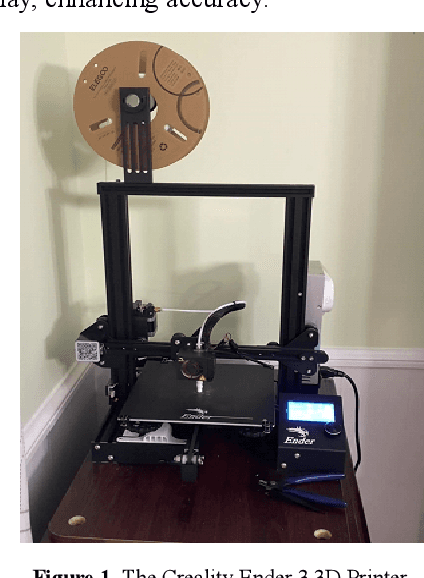
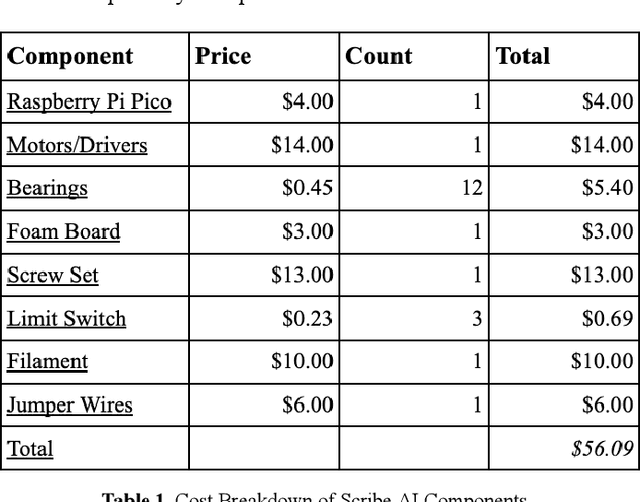
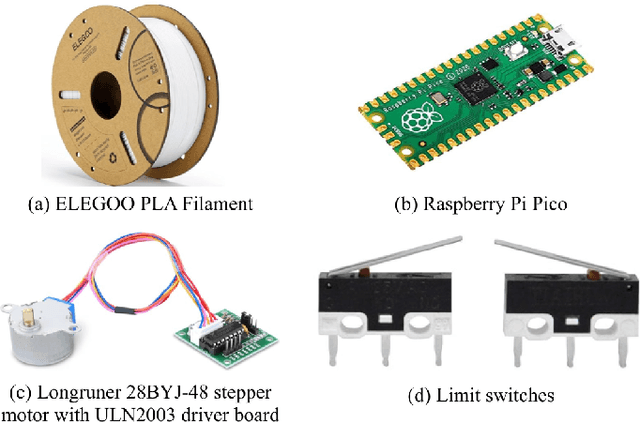
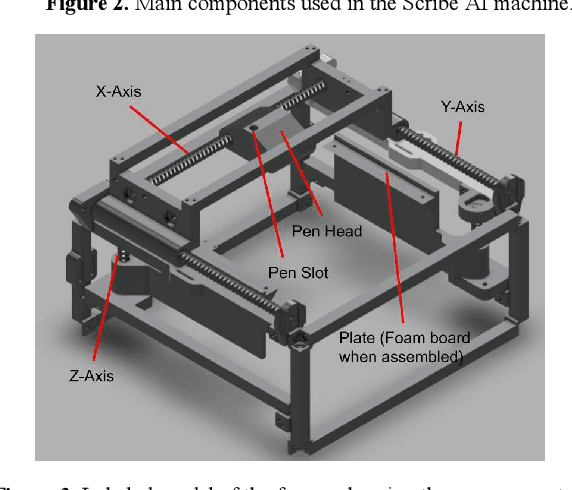
Abstract:This paper introduces a cost-effective robotic handwriting system designed to replicate human-like handwriting with high precision. Combining a Raspberry Pi Pico microcontroller, 3D-printed components, and a machine learning-based handwriting generation model implemented via TensorFlow, the system converts user-supplied text into realistic stroke trajectories. By leveraging lightweight 3D-printed materials and efficient mechanical designs, the system achieves a total hardware cost of approximately \$56, significantly undercutting commercial alternatives. Experimental evaluations demonstrate handwriting precision within $\pm$0.3 millimeters and a writing speed of approximately 200 mm/min, positioning the system as a viable solution for educational, research, and assistive applications. This study seeks to lower the barriers to personalized handwriting technologies, making them accessible to a broader audience.
* This is an updated version of a paper originally presented at the 2024 IEEE Long Island Systems, Applications and Technology Conference (LISAT)
Optimization of Transformer heart disease prediction model based on particle swarm optimization algorithm
Dec 03, 2024



Abstract:Aiming at the latest particle swarm optimization algorithm, this paper proposes an improved Transformer model to improve the accuracy of heart disease prediction and provide a new algorithm idea. We first use three mainstream machine learning classification algorithms - decision tree, random forest and XGBoost, and then output the confusion matrix of these three models. The results showed that the random forest model had the best performance in predicting the classification of heart disease, with an accuracy of 92.2%. Then, we apply the Transformer model based on particle swarm optimization (PSO) algorithm to the same dataset for classification experiment. The results show that the classification accuracy of the model is as high as 96.5%, 4.3 percentage points higher than that of random forest, which verifies the effectiveness of PSO in optimizing Transformer model. From the above research, we can see that particle swarm optimization significantly improves Transformer performance in heart disease prediction. Improving the ability to predict heart disease is a global priority with benefits for all humankind. Accurate prediction can enhance public health, optimize medical resources, and reduce healthcare costs, leading to healthier populations and more productive societies worldwide. This advancement paves the way for more efficient health management and supports the foundation of a healthier, more resilient global community.
Mitigating Bias in Queer Representation within Large Language Models: A Collaborative Agent Approach
Nov 12, 2024Abstract:Large Language Models (LLMs) often perpetuate biases in pronoun usage, leading to misrepresentation or exclusion of queer individuals. This paper addresses the specific problem of biased pronoun usage in LLM outputs, particularly the inappropriate use of traditionally gendered pronouns ("he," "she") when inclusive language is needed to accurately represent all identities. We introduce a collaborative agent pipeline designed to mitigate these biases by analyzing and optimizing pronoun usage for inclusivity. Our multi-agent framework includes specialized agents for both bias detection and correction. Experimental evaluations using the Tango dataset-a benchmark focused on gender pronoun usage-demonstrate that our approach significantly improves inclusive pronoun classification, achieving a 32.6 percentage point increase over GPT-4o in correctly disagreeing with inappropriate traditionally gendered pronouns $(\chi^2 = 38.57, p < 0.0001)$. These results accentuate the potential of agent-driven frameworks in enhancing fairness and inclusivity in AI-generated content, demonstrating their efficacy in reducing biases and promoting socially responsible AI.
High-dimensional Clustering onto Hamiltonian Cycle
Apr 27, 2023



Abstract:Clustering aims to group unlabelled samples based on their similarities. It has become a significant tool for the analysis of high-dimensional data. However, most of the clustering methods merely generate pseudo labels and thus are unable to simultaneously present the similarities between different clusters and outliers. This paper proposes a new framework called High-dimensional Clustering onto Hamiltonian Cycle (HCHC) to solve the above problems. First, HCHC combines global structure with local structure in one objective function for deep clustering, improving the labels as relative probabilities, to mine the similarities between different clusters while keeping the local structure in each cluster. Then, the anchors of different clusters are sorted on the optimal Hamiltonian cycle generated by the cluster similarities and mapped on the circumference of a circle. Finally, a sample with a higher probability of a cluster will be mapped closer to the corresponding anchor. In this way, our framework allows us to appreciate three aspects visually and simultaneously - clusters (formed by samples with high probabilities), cluster similarities (represented as circular distances), and outliers (recognized as dots far away from all clusters). The experiments illustrate the superiority of HCHC.
Detecting COVID-19 Conspiracy Theories with Transformers and TF-IDF
May 01, 2022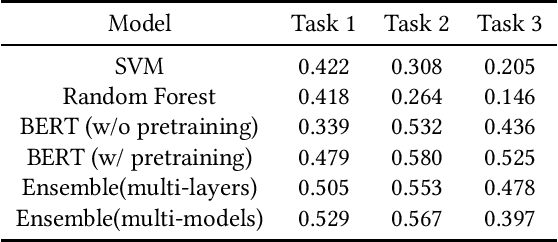
Abstract:The sharing of fake news and conspiracy theories on social media has wide-spread negative effects. By designing and applying different machine learning models, researchers have made progress in detecting fake news from text. However, existing research places a heavy emphasis on general, common-sense fake news, while in reality fake news often involves rapidly changing topics and domain-specific vocabulary. In this paper, we present our methods and results for three fake news detection tasks at MediaEval benchmark 2021 that specifically involve COVID-19 related topics. We experiment with a group of text-based models including Support Vector Machines, Random Forest, BERT, and RoBERTa. We find that a pre-trained transformer yields the best validation results, but a randomly initialized transformer with smart design can also be trained to reach accuracies close to that of the pre-trained transformer.
 Add to Chrome
Add to Chrome Add to Firefox
Add to Firefox Add to Edge
Add to Edge